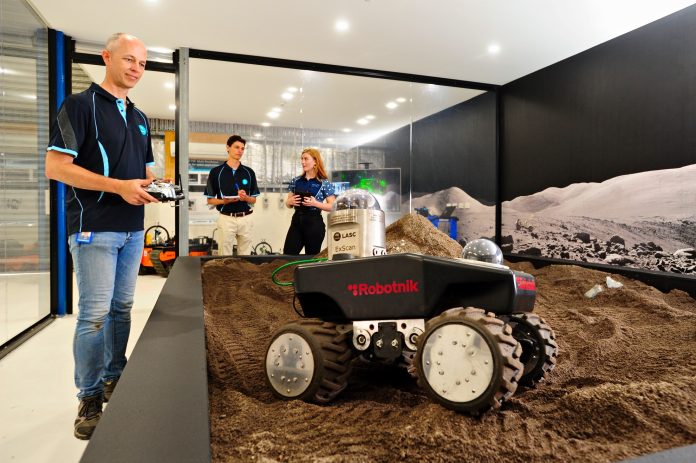
Researchers and businesses looking to go to the Moon can now test their ideas in a new facility opened by Australia’s national science organisation, CSIRO, in Brisbane.
The new In-Situ Resource Utilisation (ISRU) facility is located at CSIRO’s Queensland Centre for Advanced Technologies, home to the robotics playground where CSIRO’s robotics team trained for their silver-medal performance in the recent DARPA Subterranean Challenge.
With an initial focus on investigating lunar terrain and resources, the facility provides a Moon-like environment for testing and evaluating rovers and supporting equipment.
Astronauts on the Apollo program witnessed firsthand the difficulties of working on the Moon. The fine abrasive dust that blanketed their spacesuits and instruments was one of those problems.
ISRU features a sealed dust room for safely handling of several forms of lunar regolith simulant – synthetic Moon dust – with properties similar to those found on the Moon’s surface.
It also features smaller tanks and pits for smaller-scale tests, as well as a mission control room for remotely monitoring rovers, payloads, and related equipment.
Dr Kimberley Clayfield, director of the CSIRO Space Program, said the facility is a great addition to the facilities CSIRO oversees and would complement CSIRO’s space research and the operations of the Australian space sector.
“Our ability to simulate the lunar terrain at this scale is an exciting advancement for the development of space technology in Australia,” Dr Clayfield said.
“This facility is the latest example of our commitment to stimulating innovation, supporting industry and solving the greatest challenges through space science, technology and exploration.
“We’re looking forward to working with researchers and businesses from across the space sector to test their technology and systems for future space missions.”
Several multinational space organizations and firms are contemplating future trips to the Moon’s surface to look for resources that may be used to sustain further exploration and possibly colonization.
Dr Jonathon Ralston, CSIRO ISRU Project Leader, described how lunar regolith is both a solution and a serious issue for these robotic missions.
“We know the regolith will contain useful materials like oxygen that could be used for fuel or breathable air, however we need to first identify these elements and develop ways of extracting and processing them,” Dr Ralston said.
“The challenge is the Moon dust is powdery, sharp and electrostatically charged so it sticks to everything and has the potential to damage the technology sent to investigate it.
“Our facility offers technology developers the opportunity to test their equipment closer to home, in a safe environment to find solutions to this dusty problem.”




















